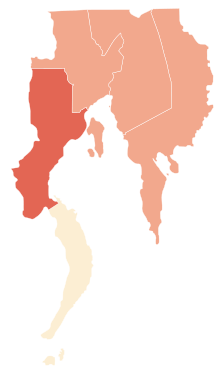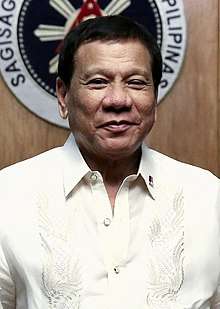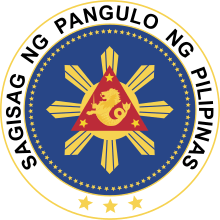COVID-19 pandemic in the Davao Region
The COVID-19 pandemic in the Davao Region is part of the worldwide pandemic of coronavirus disease 2019 (COVID-19) caused by severe acute respiratory syndrome coronavirus 2 (SARS-CoV-2). The virus reached the Davao Region on March 15, 2020, when the first case of the disease was confirmed in Tagum. All provinces as well as Davao City has at least one confirmed COVID-19 case. Majority of the cases and all deaths in the region are attributed to Davao City.
| COVID-19 pandemic in the Davao Region | |
|---|---|
 100–499 confirmed
10–99 confirmed
1–9 confirmed | |
| Disease | COVID-19 |
| Virus strain | SARS-CoV-2 |
| Location | Davao Region |
| First outbreak | Wuhan, Hubei, China |
| Index case | Tagum |
| Arrival date | March 15, 2020 (5 months) |
| Confirmed cases | 1,727 |
| Recovered | 1,047 |
Deaths | 53 |
| Government website | |
| ro11 | |
Background
Davao Region's first case was confirmed by the Department of Health's Davao Region office on March 15, 2020.[1] The case was that of a 21-year-old female resident of Pantukan, Davao de Oro who had a travel history to the United Kingdom and Manila. The patient arrived in Davao City on February 29 and was placed in isolation at a health facility on March 9 after undergoing consultation for a cough. The following day, the patient was referred to a Davao Regional Medical Center in Tagum.[2]
Timeline
A day prior to the announcement of the first confirmed case in the Davao Region on March 15, the cities of Tagum and Davao City were placed under partial lockdown.[1] The first COVID-19 eight cases in the region involved individuals who had travel history to Metro Manila which already had confirmed cases prior to the confirmation of the disease's entry to the region.[3]
By March 31, the Southern Philippines Medical Center has been certified by the Research Institute for Tropical Medicine (RITM) to independently conduct COVID-19 confirmatory tests.[4] The SPMC has also been identified as COVID-19 dedicated health facility to help relieve private hospitals in the region so that they could still cater to patients with non-COVID-19 concerns.[5]
Several cases across Mindanao, not just in the Davao Region, has been linked to cockfighting derby held in March 2020 in Matina, Davao City.[6] From April 6, cases linked to the Matina cockfighting derby has been confirmed in Davao del Norte, Davao del Sur, and Davao de Oro within the region, and in Lanao del Norte, Maguindanao, North Cotabato, South Cotabato, General Santos and Bukidnon outside the region.[3]
Six of eleven confirmed COVID-19 deaths in the Davao Region as of April 6 is attributed to the Matina cluster.[7] 18 cases in total has been linked to the cluster as of April 11.[3]
As of April 10, there are 87 confirmed cases, 13 deaths and 48 recoveries in the Davao Region. Most of which are concentrated in Davao City with 71 cases and all deaths in the region recorded in the city.[3]
Davao Occidental reported its first confirmed case on May 5, which meant that the disease has already spread to all provinces in the Davao Region.[8]
Statistics
Response
Local government
The implementation of an enhanced community quarantine in the Davao Region was announced on April 2, 2020.[9] The quarantine began at 9 pm of April 4[9] and is scheduled to end on April 19.[10] As of April 2, there were already at least 61 confirmed cases in the region, 49 of which were recorded in Davao City.[9]
Davao City
On March 15, Davao City Mayor Sara Duterte issued Executive Order No. 23, placing the entire city under general community quarantine effective on the said date. The community quarantine orders the suspension of classes, prohibiting public mass gatherings, and encouraged flexible/alternative work arrangements or suspension of work for both government and private sectors. The annual Araw ng Dabaw festival, as Duterte-Carpio previously stated, was cancelled.[11]
On April 2, Mayor Duterte issued Executive Order No. 23, placing the entire city under enhanced community quarantine from April 4 to 19. Under the enhanced quarantine, government workers are required to adapt the "work from home" policy except those who are in the security, health, and social services among others who continue to work in full operation. It also allows workers in the private sector involving essential services. Public transport is also suspended except those who are hired to work by the city government.[12]
Unlike other local governments that have also imposed an enhanced community quarantine, Mayor Sara Duterte allowed the operation of most public transportation modes in the city, albeit taxis and tricycles should only accept two passengers per ride, while motorcycle ridesharing companies accept only one. On her rationale for allowing public transportation to continue operating in the city, Duterte said that she wanted to reprieve the general public from "walking more than 20 km just to buy food and other basic necessities."[13]
Davao del Norte
The local government of Samal has also barred all foreigners coming from countries affected by the coronavirus pandemic as well as all individuals suspected to have been infected with the virus, and those who were previously quarantined from entering the island city.[14]
Religious sector
On March 14, the Roman Catholic Archdiocese of Davao suspended all religious activities but has allowed airing Masses on television, radio and online.[15]
Notes
- Breakdown of confirmed cases is according to the COVID-19 Case Tracker of the Department of Health. The map above groups Davao City's cases with the province Davao del Sur. The city is often grouped with the province for statistical purposes.
References
- Lumawag, Reuel John (March 15, 2020). "DOH confirms first Covid-19 case in Davao". Sun Star. Retrieved April 14, 2020.
- Colina, Antonio IV (March 23, 2020). "Davao region's first COVID-19 patient recovers, discharged from hospital". MindaNews. Retrieved April 11, 2020.
- Arguillas, Carolyn. "18 COVID-19 cases outside Davao City linked to Matina Gallera derby". MindaNews. Retrieved April 14, 2020.
- Caro, Kevin (March 31, 2020). "SPMC can now independently test for COVID-19". Philippine Information Agency. Retrieved April 11, 2020.
- "Resources poured into SPMC to reduce infection in private hospitals". Philippine Information Agency. April 8, 2020. Retrieved April 11, 2020.
- Cadelina-Manar, Malu (April 10, 2020). "Another COVID-19 case in NorthCot also attended the Matina Gallera derby". Mindanews. Retrieved April 11, 2020.
- Arguilas, Carolyn (April 7, 2020). "6 of 11 COVID-19 deaths in Davao region traced to cockpit derby; contact tracing has not reached "even a third"". Mindanews. Retrieved April 11, 2020.
- "Davao Occidental reports first confirmed COVID-19 case". CNN Philippines. May 5, 2020. Retrieved May 5, 2020.
- Causon, Andoreena (April 2, 2020). "Davao Region to be placed under enhanced community quarantine on Saturday". ABS-CBN News. Retrieved April 2, 2020.
- Bulosan, Chrislen (April 14, 2020). "COVID-19 in Davao region contained, claims hospital chief". ABS-CBN News. Retrieved April 14, 2020.
- "Davao City under community quarantine". Rappler. March 15, 2020. Retrieved April 3, 2020.
- Llemit, Ralph Lawrence (April 2, 2020). "Davao City under community quarantine". Sun Star. Retrieved April 3, 2020.
- Araneta, Vina (April 6, 2020). "Why Mayor Sara is allowing taxis, tricycles in Davao City amid enhanced community quarantine". ABS-CBN News. Retrieved April 7, 2020.
- "Samal Island bars entry of Chinese, other foreign tourists from coronavirus-hit countries". CNN. January 30, 2020. Retrieved February 15, 2020.
- "Davao Archbishop on pandemic: 'We shall overcome'". Sun Star. April 11, 2020. Retrieved April 11, 2020.

